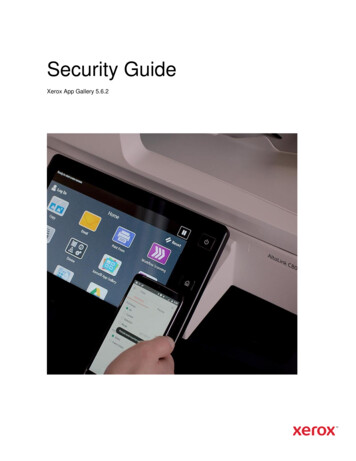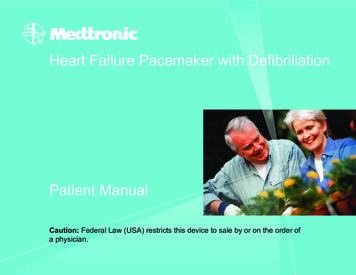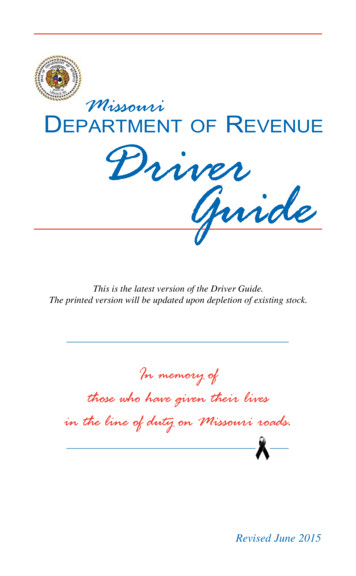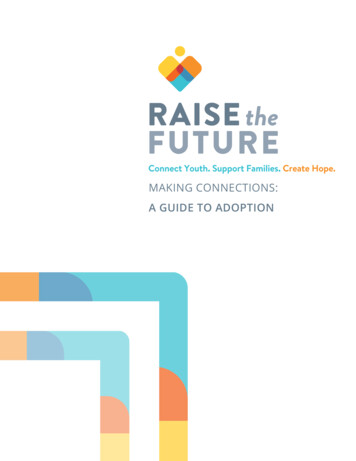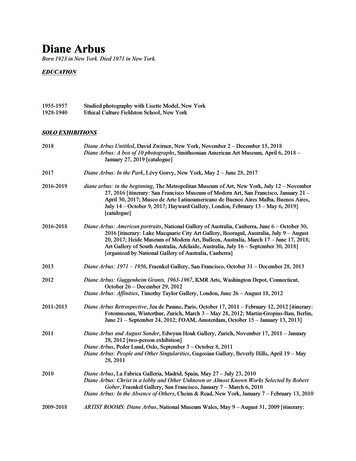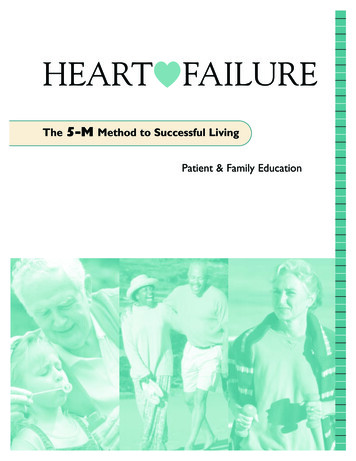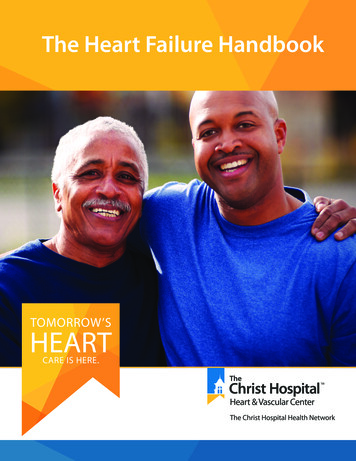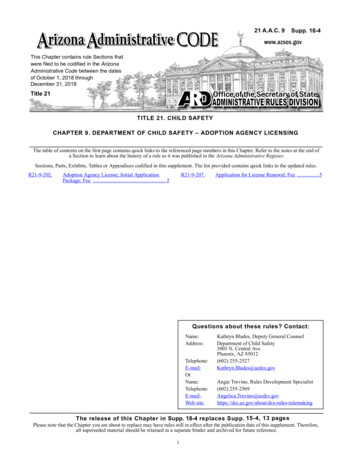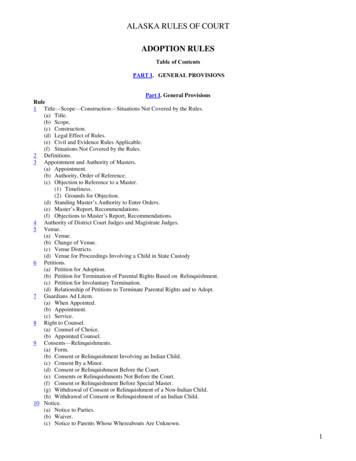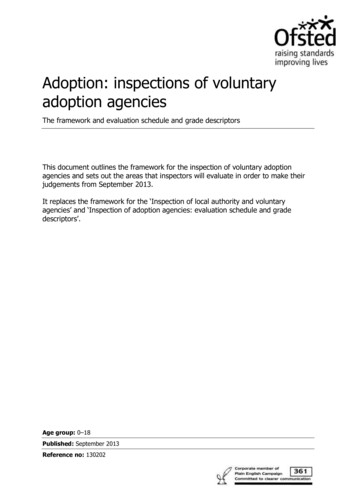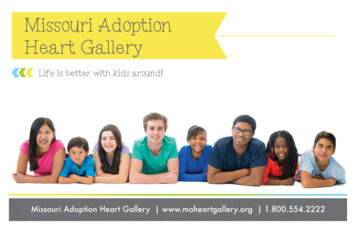
Transcription
Missouri AdoptionHeart GalleryLife is better with kids around!
About the MissouriHeart GalleryThere are currently more than1,200 Missouri children in fostercare who are unable to return totheir biological parents and are inneed of adoptive parents to providea permanent home and a familyto help them move forward intheir life.That’s why in 2006, Missouribegan the Heart Gallery project.The Missouri Heart Gallery helpschildren in foster care who arewaiting for adoptive families tostep from the shadows into thelight in a unique way. MissouriAdoption Heart Gallery and thewebsite, MOHeartGallery.org,features stirring portraits of thesechildren which reveal their amazingspirit and individuality. Thanks to2
the Heart Gallery, many childrennow have a family of their own tocelebrate milestones and holidayswith and loving parents theydeserve, to comfort, support, andguide them.In addition to adoptive parents,Missouri is always looking for fosterparents to provide safe and caringtemporary homes for childrenwhose families are currently unableto care for them. There are morethan 13,000 Missouri children infoster care. Throughout a child’sstay, foster parents are invaluablemembers of the team who workstogether to meet the needs of thefamily in order to safely return thechild home whenever possible.The Missouri Heart Gallery website,MOHeartGallery.org, also providesinformation about becoming afoster or adoptive parent. Thereis also a toll-free number forprospective foster and adoptiveparents to call with questions, aswell as YouTube commercials thatorganizations and advocates caninclude on their website orsocial media.The Missouri Heart Gallery is ajoint effort between the MissouriDepartment of Social ServicesChildren’s Division and TheAdoption Exchange-Missouri office.with special needs since 1983. TheAdoption Exchange recruits familiesfor our country’s most vulnerablechildren who currently wait in fostercare. For more than 30 years, theAdoption Exchange has offeredhope and helped find families formore than 8,000 children.RTo learn more about howyou could help changea child’s life, please visitMOHeartGallery.orgThe Adoption Exchange has beenmaking the connection betweenadoptive families and children3
Adoption, Foster Care& Training InformationAdoption OverviewAdoptive families provide apermanent home to a child in care.Adoption is the legal transfer ofparental rights and responsibilitiesfrom a child’s birth parents to theadoptive parents.Many of the children who wait tobe adopted from foster care areage five or older, are of minoritydecent, have siblings who alsoneed adoptive parents, and havelived in multiple foster homes.Foster Care OverviewFoster parents provide temporarycare for children whose familiesare not currently able to care forthem. Foster parents provide a safeand supportive home and help tomeet a child’s emotional, physical,and social needs while they are4in care. Foster parents offergeneral guidance for growth anddevelopment to a child and theirfamily, while supporting the child’srelationships with kin and otherswho are important to them.Throughout a child’s stay, fosterparents are active professionalmembers of the team whichconsists of the child’s worker, thechild and their family, the court andcommunity members who worktogether to safely return the childhome whenever possible.Training OverviewThe first step toward becominga foster or adoptive parent is theagency’s assessment andtraining program.All foster and adoptive parentsare required to successfullycomplete our Specialized Training,Assessment, Resources, Supportand Skills (STARS) program.The STARS program introducesprospective foster and adoptivefamilies to the rewards andchallenges involved in caringfor Missouri’s most vulnerablechildren. The sessions also offeran opportunity to have questionsanswered, build relationships withother parents and agency staff, andto determine if foster or adoptiveparenting is the right choice.The STARS program is importantfor even the most experiencedparents because fostering andadopting is very different fromparenting a biological child.Foster and adoptive parents mustsupport the relationship betweenthe child and his/her birth familyand help the child manage feelings
about being in foster care, or thepossibility of being adopted.STARS is a pre-service trainingprogram that strives to prepareyou to:RR Protect and nurture foster andadoptive children;RR Meet children’s developmentalneeds and addressdevelopmental delays;RR Support relationships betweenchildren and their families;RR Connect children with safe,nurturing relationships intendedto last a lifetime; andRR Actively participate in aprofessional team.STARS also includes an in-homeassessment consisting of at leastfour visits to your home by aResource Development worker.The worker will discuss informationwith you about our agency andthe children in our care, as well astalk with you about your family. Heor she will also look at your homeenvironment for compliance withlicensing requirements. Part ofthe assessment process is to helpyou make important decisionsabout whether or not fostering oradopting a child is right for youand your family.Additional training is requiredfor prospective adoptive families.These classes offer tools andinformation needed to:RR Understand how adoptivefamilies are different;RR Anticipate the effects ofseparation, loss, and griefin adoption;RR Understand the need tomaintain optimal connectionwith those who matter tothe child;RR Understand attachment and itsimportance in adoption;RRAnticipate challenges andidentify strategies for managingchallenges as an adoptivefamily; andRR Explore the lifelong commitmentto a child that adoption requires.Training sessions provide theopportunity to have questionsanswered, build relationships withother parents and agency staff, andto determine whether your familyhas the ability and desire to meetthe children’s needs.5
Foster Care and AdoptionFrequently Asked QuestionsWhat is foster care?Foster care is a temporary placement for children withoutparental care due to abuse or neglect. Foster familiesprovide a safe and nurturing home while the biologicalparents receive support services to regain custody oftheir children.What is adoption?Adoption is the permanent home option for children whohave been in foster care. Children are legally free foradoption only after the court has terminated the parentalrights of the birth parents.Who are the children in foster care orawaiting adoption?Children in foster care range in age from 0 to 21 andfrequently have siblings who must remain together. Morethan half are of minority decent. Some of these childrenhave physical, mental or emotional disabilities rangingfrom mild to severe. Children enter foster care due toabuse, neglect, or abandonment. All have endured the6
trauma of being separated fromtheir families. Just as each childis an individual, the challengesin meeting their needs will vary,but they all need patience,understanding andunconditional love.Do I have to be married?You do not have to be married.Do I have to own myown home?Foster and adoptive parents donot have to own their own home;in fact, many foster and adoptiveparents rent their residence.What are the costs of becominga foster or adoptive parent?There is little to no cost involvedin becoming a foster or adoptiveparent. The home assessment andtraining is provided by the statefree of charge. The majority ofadoption expenses are covered bythe state.Do I have a choice in whichfoster children are placedin my home?Your individual parenting skillsand the capacity of your home willbe matched with the informationyou provide in regard to childpreferences. This allows the agencyto identify when you, as a parent,are most likely to meet the uniqueneeds of a child in the state’s care.The assessment process is on-goingand part of the continuing licensureprocess. It is crucial that homes beidentified that will best meet theparenting needs of children in care.Even if your home is identified assuitable for a specific child, fosterparents have the option to declinethe placement.What type of support servicesare provided after a child isplaced in my home?Foster parents receive a monthlymaintenance payment to helpcover the costs of caring fortheir foster children. Medicaid isprovided by the state for the child’smedical, psychological and dentalneeds. Additionally, foster parentsand adoptive parents who areemployed or enrolled in schoolfull time may be able to receivechildcare services. Visitation plansfor children and their families arealso part of the supportive servicesoffered to maintain and preservethose essential relationships and7
To be a foster or adoptiveparent, you must:connections that are vital toa child’s developmentand reunification.What are the age requirementsto become a foster oradoptive parent?The minimum age is 21. There isno maximum age limit.What are the trainingrequirements for becomingfoster or adoptive parents?Both foster and adoptive parentsare required to complete a 27hour pre-service program calledSpecialized Training, Assessment,Resources, Support and Skills(STARS). Foster parents arerequired to complete 30 hoursof in-service training during theirtwo-year licensure period. In two8parent homes, both parents mustcomplete the required number oftraining hours. An additional 12hours of specialized training isrequired for individuals or coupleswishing to adopt.Do I have to foster before Ican adopt?No, you do not have to become afoster parent before you are ableto become an adoptive parent.RRBe at least 21 years of age;RR Complete a child abuse/neglectcheck and criminal record checkincluding fingerprints;RR Be in good health,both physically and mentally;RRHave a stable income;RR Be willing to participate in andcomplete a free training andassessment process;RR Be part of a professional teamwilling to voice perspectives andconcerns; andRR Be willing to partner withthe child’s family.You can:RRBe with or without children;RRBe single or married; andRR Own or rent a home, apartment,condo, or other residence thatmeets the licensing standards.
Ways you can help childrenliving with foster familiesin your community:RR Hold luggage/backpack driveRR Tutor or mentor children/youthRRProvide respite careRRProvide special holiday helpRR Make a monetary donationfor: new glasses, new shoes forstarting school, school pictures,haircuts, hair and/or nailservices for prom, yearbook,class ring, graduation capand gown, prom dress, tuxedorental, sports equipment oruniforms, extracurricular orsummer activitiesRR Donate items for children andyouth: children’s books, schoolsupplies, musical instruments,new items such as underwear,socks, coats, or earrings, phonecards for youth to stay closeto family, treats for a child todistribute at school on specialoccasions, fingernail polish,or makeupRR Donate items for foster families:laundry detergent, fabricsoftener, bedding, toothbrushes,deodorant, hair care supplies,Christmas ornaments, giftcertificates for a resource familynight at a local restaurant or atthe movies9
Home Sweet Home:Three Families GrowBy Adopting Children Through Foster Care10
11
Home Sweet Home:Katie*To protect the privacy of adopted children and their families, names have been changed and stock photography was used to depict children and/or their families.12
R Katie’s Dad, Ryan:We weren’t looking to adopt again.At that time, our oldest adopteddaughter had been settled in forfive years and was getting close tograduating from high school. Still,I was curious about the waitingkids out there. I looked at theHeart Gallery and the AdoptionExchange lists once a week. Wouldthese kids get placed? How longdid they wait? But then I saw Katie’spicture. Veterans of two multi-racialadoptions, looks were not whatmattered to us. Regardless, what Isaw in Katie was a preteen girl thatlooked like my wife, but with mynose and my blue eyes. My heartclaimed her and I couldn’t get outof my head that this could be ourdaughter, and she was out there,waiting.“People ask me manytimes, do you love youradopted kids as muchas your biological ones?The answer is anoverwhelming yes, andsometimes it happens evenbefore you meet them. “For the next year I kept askingabout her, even waiting throughanother match she had that failed.My wife thought I was a little loony,but in the end, my heart was right.She was our daughter, she is ourdaughter, and she always will be.When we brought her home, shestill had the hat she wore in herHeart Gallery pictures. A symbolof her past that we had neverseen, the hat was foreign, but itdisappeared quickly. She left hername behind as well because shewanted a fresh start with a newattitude. Dawn was the girl in theHeart Gallery, but Katie moved inwith us.People ask me many times, do youlove your adopted kids as much asyour biological ones? The answeris an overwhelming yes, andsometimes it happens even beforeyou meet them.She’s growing up fast now; drivinga car, getting a job, and gettingasked out to prom. I’m proud ofthe changes she has made and thewoman she is becoming. Otherdads are upset because their littlegirls grow up quickly, but I’m justglad I didn’t miss more.13
R Katie:When I was in foster care, I alwaysdreamt of a big happy family witha lot of kids and animals. I wantedthem to love Chinese food justlike me and eat it AT LEAST threetimes a week! I wanted to live ona farm with horses and baby pigsand chickens. Being in foster carethough, I had a lot on my mind anddidn’t necessarily think about mydream forever family a lot. I wasvery angry at the world so I lashedout at everyone around me. Thismade me feel like a monster butI knew that I was only protectingmyself; or so I thought. I hadmultiple families try and take meon to adopt me but I was too muchof a struggle for them. After beingin the foster care system for almosteight years, my real forever family14came along and changed mylife forever.Two days battle for the best day ofmy life: the day I met my foreverparents and the day I was officiallyadopted. When I met my parents,they had known me for about ayear. I had no clue though; all Iknew is that I liked them! They toldme stories about their family (soonto be mine as well) and how theyhad four other kids who all lovedChinese food! You wouldn’t believehow excited I was. Even though theydidn’t live on a farm and my “momto be” was allergic to my favoriteanimal (horse), I didn’t care. I wasjust grateful to have the chance tohave my own forever family.The day of my adoption was scaryand exciting. We thought of itmuch like a wedding ceremony, Iwas being formally united with myfamily forever. I wore a white dressthat resembled a wedding dresswith a red bow and sparkly redheels. That day was perfect, and Ieven remember the judge. He wasawesome and so happy for me too!I will never forget that day.“My real foreverfamily came alongand changed mylife forever.”The first couple of weeks with mynew family were scary and I feltlike I was stepping on brokenglass. I tried my best to be on mybest manners and to behave well.
After a while though, I started totrust them. I let out a few burpsonce and a while and they didn’teven care! Once I felt a little saferI started acting out because I stilldidn’t fully trust my family andespecially my new parents. This lifeseemed like it was too good to betrue, so I “tested the waters” for awhile before I knew I could fullytrust them. Once I did, I knew that Iwould always be safe, forever. Thatwas the best feeling that I hadever had.R Katie15
Home Sweet Home:James, Sarah, Jacob & John*To protect the privacy of adopted children and their families, names have been changed and stock photography was used to depict children and/or their families.16
Noah and Mary began theirjourney as foster and adoptiveparents many years ago. Sincethen, they have adopted twelvechildren and greatly extended theirfamily. “We felt like God wantedus to reach out,” Mary explained,“There is such a need for childrento have a home for a lifetime.”About two years ago, the familyadopted James and a sibling groupof three who had been featured inthe Missouri Heart Gallery. At thetime of adoption, James was 14years old, and the three siblings,Sarah, Jacob, and John were 11,10, and 9.According to Sarah, being a partof a forever family has taught herabout “responsibility, hard work,and how to notice the feelings ofother people.” Jacob said, “I’veespecially been learning to showlove for my brothers, sisters andparents. They’ve been teaching meabout God.” John, the youngest ofthe siblings, excitedly added, “Wehave a lot of fun and goplaces together!”The older age of the children didnot detour this family, as theysaw potential in all of them. “Justbecause they are older doesn’tmean they do not still need timeand love,” they explained.Jacob said the best part aboutbeing adopted is “belonging,feeling wanted, and having hopefor my future.” James explainedthat it felt good to have parentsthat love him unconditionally andwill stick with him through the goodand the bad times.Noah and Mary said that if theyhad just one piece of advice tothose interested in adoption, itwould be to: “Be strong and becommitted.” By opening theirhome and hearts to these children,Noah and Mary have allowedthem to learn and grow in a stableenvironment. When asked, all ofthe children agreed that having aforever family meant that they feel“loved, happy and cared for.”R James, Sarah,Jacob & John17
Home Sweet Home:Emily*To protect the privacy of adopted children and their families, names have been changed and stock photography was used to depict children and/or their families.18
When Amy first met Emily, 19,she explained it “just fit.” “I can’texplain it,” Amy said, “it justclicked. I felt like her motherright away.”Both sets of Amy’s grandparentshad adopted, so she was exposedto the process early on. Even as achild, Amy knew she would like toadopt one day. Her heart brokefor those children who didn’t havesomeone to call “mommy,” andshe always felt like every child, nomatter their age, should have amom. “When they go to collegeand start having their own family;they still need their mom,”Amy explained.Amy is a single mother of two anda foster mother. “Patience andunderstanding is key to filling inthe blanks, it is important to nevergive up – even when boundariesare tested,” Amy stated. Emilywas placed with Amy at age 19and legally adopted at 20. Onceadopted, Emily not only gained amother, but gained siblings as shebecame an older sister. Emily nevergave up on the idea of finding aforever family, and she feels like it’simportant for older youth to knowthat a forever family “will comewhen you least expect it.”“Family to us is love,” Amyexplained. “Love makes a housea home.”R EmilyFor Emily, the best part of beingadopted is having somewhere tocall home. “I have a place I belong,and I have a family that doesn’tcare if I need time alone or that Idon’t like hugs,” Emily said. “Theystill love me, and they always will.”Emily is currently living in her ownapartment, working andattending college.19
For information on how tobecome a foster or adoptive parent,please call toll free at: 1.800.554.2222or visit us online at MOHeartGallery.org
Adoption Exchange-Missouri office. The Adoption Exchange has been making the connection between adoptive families and children with special needs since 1983. The Adoption Exchange recruits families for our country's most vulnerable children who currently wait in foster care. For more than 30 years, the Adoption Exchange has offered
